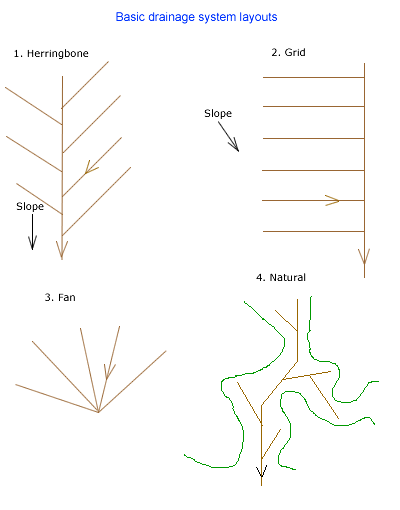Basic Pipe Drainage Systems
Introduction
Pipe drainage systems are usually based on one of four main designs. Herringbone and Grid systems are the commonest, however, Fan and Natural systems also have a place within certain circumstances.

Herringbone
This system provides for a main central pipe, which runs down a slope, that has lateral pipes connecting to it at acute angles.
This type of design is typically used on areas that are irregular in shape and will include golf greens and large general amenity playing fields.
An advantage of a herringbone design is that less depth is needed for excavated drains to achieve the necessary falls.
However, the disadvantages are that the designs are more complicated and expensive to install than the Grid system. In addition if the pipe system is later upgraded with sand-gravel slits, then there will be a variable slit length before the slit discharges its water because of the angled layout of the herringbone design.
Grid (also called Gridiron or Parallel)
This system has a main pipe, or pipes, at the perimeter of an area with laterals joining the main pipe either at right angles or an acute angle.
The main pipe will either run along or near to the line of the fall of the land.
The lateral pipes will typically cross the fall of the land in a diagonal fashion.
This type of design is typically used on regular shaped areas such as football/rugby pitches and bowling greens.
A grid system is probably the commonest type of system that is installed in turf areas because it is easier to install, has less junctions than a herringbone system and can also be easily upgraded with the addition of sand/gravel slits.
Fan
This system is used for small or irregular shaped areas.
Typically this would be a localised low lying wet area and may also include parts of a golf fairway. A golf green may also be considered, however, a herringbone system would be used in the majority of cases.
All pipes in a fan system are laterals that connect directly to an outlet.
Natural (also called Random or Contour)
This can be used on 'natural' amenity grasslands and golf fairways. The system of pipes follow the natural contours of the land, with the main pipe being installed in the low areas and laterals connecting to it from adjacent areas.
Further Reading
- Gooch & Escritt, (1974), 'Sports Ground Construction. Specifications', NPFA & STRI, 126pp
- Adams, W.A. & Gibbs, R.J., (1994), 'Natural Turf for Sport and Amenity: Science and Practice', CAB International, 404pp
- Stewart, V.I., (1994), 'Sports Turf Science, Construction and Maintenance', E & F.N. Spon, 260 pp
